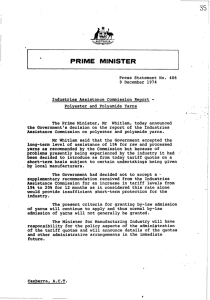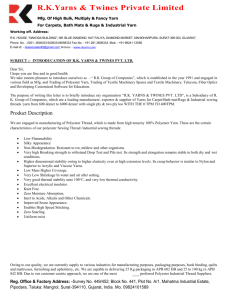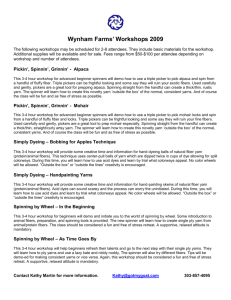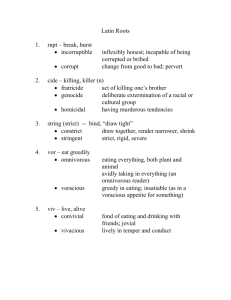Effects of Vacuum Steaming Process Sibel Şardağ, Özcan Özdemir
advertisement
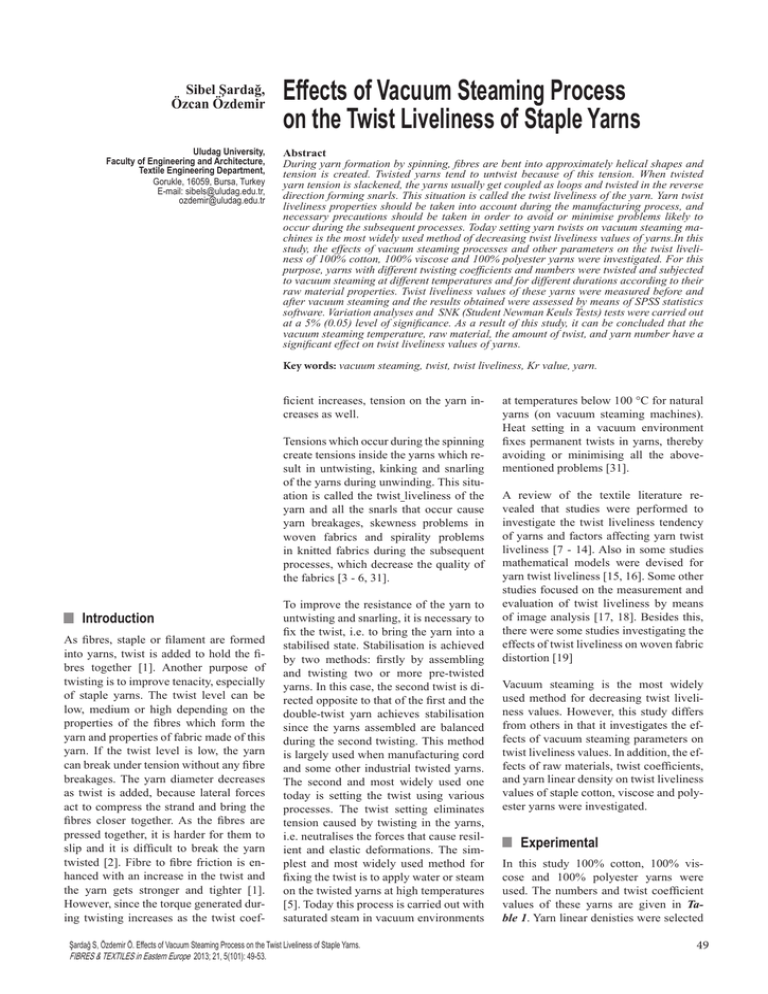
Sibel Şardağ, Özcan Özdemir Uludag University, Faculty of Engineering and Architecture, Textile Engineering Department, Gorukle, 16059, Bursa, Turkey E-mail: sibels@uludag.edu.tr, ozdemir@uludag.edu.tr Effects of Vacuum Steaming Process on the Twist Liveliness of Staple Yarns Abstract During yarn formation by spinning, fibres are bent into approximately helical shapes and tension is created. Twisted yarns tend to untwist because of this tension. When twisted yarn tension is slackened, the yarns usually get coupled as loops and twisted in the reverse direction forming snarls. This situation is called the twist liveliness of the yarn. Yarn twist liveliness properties should be taken into account during the manufacturing process, and necessary precautions should be taken in order to avoid or minimise problems likely to occur during the subsequent processes. Today setting yarn twists on vacuum steaming machines is the most widely used method of decreasing twist liveliness values of yarns.In this study, the effects of vacuum steaming processes and other parameters on the twist liveliness of 100% cotton, 100% viscose and 100% polyester yarns were investigated. For this purpose, yarns with different twisting coefficients and numbers were twisted and subjected to vacuum steaming at different temperatures and for different durations according to their raw material properties. Twist liveliness values of these yarns were measured before and after vacuum steaming and the results obtained were assessed by means of SPSS statistics software. Variation analyses and SNK (Student Newman Keuls Tests) tests were carried out at a 5% (0.05) level of significance. As a result of this study, it can be concluded that the vacuum steaming temperature, raw material, the amount of twist, and yarn number have a significant effect on twist liveliness values of yarns. Key words: vacuum steaming, twist, twist liveliness, Kr value, yarn. ficient increases, tension on the yarn increases as well. Tensions which occur during the spinning create tensions inside the yarns which result in untwisting, kinking and snarling of the yarns during unwinding. This situation is called the twist liveliness of the yarn and all the snarls that occur cause yarn breakages, skewness problems in woven fabrics and spirality problems in knitted fabrics during the subsequent processes, which decrease the quality of the fabrics [3 - 6, 31]. nIntroduction As fibres, staple or filament are formed into yarns, twist is added to hold the fibres together [1]. Another purpose of twisting is to improve tenacity, especially of staple yarns. The twist level can be low, medium or high depending on the properties of the fibres which form the yarn and properties of fabric made of this yarn. If the twist level is low, the yarn can break under tension without any fibre breakages. The yarn diameter decreases as twist is added, because lateral forces act to compress the strand and bring the fibres closer together. As the fibres are pressed together, it is harder for them to slip and it is difficult to break the yarn twisted [2]. Fibre to fibre friction is enhanced with an increase in the twist and the yarn gets stronger and tighter [1]. However, since the torque generated during twisting increases as the twist coef- To improve the resistance of the yarn to untwisting and snarling, it is necessary to fix the twist, i.e. to bring the yarn into a stabilised state. Stabilisation is achieved by two methods: firstly by assembling and twisting two or more pre-twisted yarns. In this case, the second twist is directed opposite to that of the first and the double-twist yarn achieves stabilisation since the yarns assembled are balanced during the second twisting. This method is largely used when manufacturing cord and some other industrial twisted yarns. The second and most widely used one today is setting the twist using various processes. The twist setting eliminates tension caused by twisting in the yarns, i.e. neutralises the forces that cause resilient and elastic deformations. The simplest and most widely used method for fixing the twist is to apply water or steam on the twisted yarns at high temperatures [5]. Today this process is carried out with saturated steam in vacuum environments Şardağ S, Özdemir Ö. Effects of Vacuum Steaming Process on the Twist Liveliness of Staple Yarns. FIBRES & TEXTILES in Eastern Europe 2013; 21, 5(101): 49-53. at temperatures below 100 °C for natural yarns (on vacuum steaming machines). Heat setting in a vacuum environment fixes permanent twists in yarns, thereby avoiding or minimising all the abovementioned problems [31]. A review of the textile literature revealed that studies were performed to investigate the twist liveliness tendency of yarns and factors affecting yarn twist liveliness [7 - 14]. Also in some studies mathematical models were devised for yarn twist liveliness [15, 16]. Some other studies focused on the measurement and evaluation of twist liveliness by means of image analysis [17, 18]. Besides this, there were some studies investigating the effects of twist liveliness on woven fabric distortion [19] Vacuum steaming is the most widely used method for decreasing twist liveliness values. However, this study differs from others in that it investigates the effects of vacuum steaming parameters on twist liveliness values. In addition, the effects of raw materials, twist coefficients, and yarn linear density on twist liveliness values of staple cotton, viscose and polyester yarns were investigated. nExperimental In this study 100% cotton, 100% viscose and 100% polyester yarns were used. The numbers and twist coefficient values of these yarns are given in Table 1. Yarn linear denisties were selected 49 Table 1. Characteristics of yarns and vacuum steaming process parameters applied to the staple yarns. Raw material Twist coefficient Yarn count, tex Vacuum steaming temperature, ºC Vacuum steaming duration, min 100% Cotton, 100% Viscose αt = 38, 48, 67 37 20 70 80 90 30 40 50 100% Polyester αt = 38, 48, 67 37 20 90 100 110 40 50 60 um steaming temperatures and durations used in this study were determined by taking into account those employed at textile plants and those given in the catalogues and documents of vacuum steaming machine manufacturers [20 - 22, 32, 33]. Cotton, viscose and staple polyester yarns were subjected to vacuum steaming on an Obem (Italia), a vacuum steaming machine which operates on a direct method and provides 75% vacuuming. The processes given below were followed while subjecting cotton, viscose and polyester yarns to vacuum steaming on steaming machines [23]. 1. Initial vacuum: 2 minutes, - 0.08 MPa 2.Heating: Duration varies depending on the heat desired 3. Waiting period: 30, 40, 50 and 60 minutes for cotton and viscose yarns 40, 50 and 60 minutes for staple polyester yarns 30, 45, and 60 minutes for polyester filament and polyamide 6 yarns 4. Vacuum balance: 2 minutes at - 0.08 MPa Kr values Figure 1. Kringel Factor Meter Test Equipment [24]. at = 38 at = 48 at = 67 37 tex 20 tex Figure 2. Average twist liveliness values for staple yarns before vacuum steaming. from the values widely used in spinning plants. However, when selecting twist coefficients, in addition to those which are widely used at textile plants such as αt = 38 and αt = 48, a high twist coefficient (αt = 67) was also chosen because it is the most important factor affecting twist liveliness values. The fineness and length of the viscose and staple polyester fibres used were 50 1.32 dtex, and 38 mm, respectively. The 2.5% length in mm, uniformity in %, micronaire value, and tenacity in cN/tex values of the cotton fibres used in this study were 28.2 mm, 82.5%, 4.4 micronaire, and 31.1 cN/tex, respectively. The yarns were subjected to vacuum steaming under the conditions given in Table 1 in order to examine the effects of the temperature and duration. The vacu- Twist liveliness values of the yarns were measured on a Keissokki Kringel Factor Meter. Five measurements of twist liveliness were taken for each yarn and the values obtained were expressed as Kr [24]. Measurements of twist liveliness values of the yarns were made according to instruction manual no. 507-70011 of Kringel Factor Meter testing equipment (Figure 1). Parts between the lines on the test equipment were numbered between 0 - 10 and each unit was divided into five parts. Each line indicates a 0.2 value. The more twists the yarn has, the higher its Kr value is [24]. Twist liveliness values of each yarn were measured before and after vacuum steaming in order to calculate percentage changes which occur in twist liveliness values of yarns after vacuum steaming. All the yarns were conditioned for 24 hours under standard atmospheric conditions (20 ± 2 ºC and 65 ± 2% humidity) before these measurements were taken. The effect of vacuum steaming parameters (temperature and duration) and twist coefficient on the twist liveliness values were evaluated by means of SPSS statistics software using variance analysis at a 5% (0.05) level of significance. FIBRES & TEXTILES in Eastern Europe 2013, Vol. 21, No. 5(101) Table 2. Changes in twist liveliness of cotton, viscose and staple polyester yarns after vacuum steaming. Twist coefficient (αt), - Vacuum steaming Vacuum temperature, steaming ºC duration, min 70 38 80 90 70 48 80 90 70 67 80 90 Changes in Kr value, % Cotton Viscose 37 tex 20 tex 37 tex 20 tex 30 -25.8 -39.2 -90.4 -88.6 40 -34.9 -40.8 -91.1 -90.1 50 -27.6 -36.5 -81.6 30 -36.5 -35.0 40 -37.1 50 Vacuum steaming temp, ºC Changes in Kr Vacuum value, % steaming Staple polyester duration, min 37 tex 20 tex 40 -57.3 -64:0 50 -70.4 -45.4 -80.1 60 -68.8 -66.3 -90.2 -84.3 40 -68.0 -66.5 -31.7 -86.2 -88.0 50 -72.4 -69.1 -38.7 -37.8 -87.0 -83.3 60 -72.7 -77.1 30 -30.4 -34.4 -75.2 -78.9 40 -77.5 -80.9 40 -32.3 -37.8 -87.7 -88.4 50 -77.0 -77.5 50 -31.8 -37.0 -93.5 -95.0 60 -76.8 -60.1 30 -31.4 -40.0 -92.3 -93.0 40 -58.2 -65.9 40 -27.1 -42.8 -94.6 -92.9 50 -52.2 -52.9 50 -34.0 -41.5 -81.9 -79.7 60 -57.6 -54.2 30 -24.1 -39.1 -89.8 -91.1 40 -74.6 -70.6 40 -32.6 -43.9 -89.0 -89.6 50 -68.9 -68.9 50 -35.6 -42.3 -80.6 -83.1 60 -69.5 -70.9 30 -25.9 -39.1 -83.0 -83.8 40 -78.8 -78.2 40 -38.6 -41.2 -90.6 -88.4 50 -80.2 -75.4 50 -29.6 -37.4 -94.5 -93.7 60 -72.2 -70.5 30 -39.9 -40.0 -92.6 -93.9 40 -56.5 -45.1 40 -38.9 -35.7 -91.5 -95.2 50 -60.5 -57.6 50 -34.2 -34.3 -88.1 -87.2 60 -49.2 -46.3 30 -37.1 -40.3 -91.1 -93.6 40 -60.1 -57.9 40 -38.3 -31.2 -91.9 -94.4 50 -61.4 -62.1 50 -35.5 -45.9 -90.3 -83.2 60 -61.4 -66:0 30 -40.0 -40.1 -83.6 -86.4 40 -75.4 -73.3 40 -48.9 -45.3 -92.5 -92.0 50 -68.4 -66.0 50 -44.6 -41.0 -94.8 -93.6 60 -67.0 -65.3 nResults and discussion In this section, the effects of vacuum steaming parameters (temperature and duration), raw material, twist coefficient and yarn count on yarn twist liveliness values were investigated. Effects of raw material on twist liveliness before vacuum steaming According to the results given in Figure 2, cotton, viscose and polyester yarns with the same count and twist coefficients have different twist liveliness values. Viscose yarns have the lowest twist liveliness values, whereas the polyester yarns have the highest . These differences result from those in the bending and twist rigidities of fibres in these yarns. Bending and twist rigidities of yarns depend on the elasticity modulus, shape, thickness and inner structure of the fibres which form these yarns. The elasticity modulus is governed by the intrinsic nature of the fibre’s substance, i.e. the arrangement of atoms in the molecule, the amount of crystallinity, and molecular orientation [25 - 27]. As the rate of crystalline regions in the molecular structure of the fibre increases, FIBRES & TEXTILES in Eastern Europe 2013, Vol. 21, No. 5(101) its modulus and stiffness increases as well [26, 27]; therefore, the bending and twisting capacities of the fibre decrease. However, as the rate of the amorphous regions in the fibre increases, its elasticity modulus decreases, thereby increasing its bending and twist capacities [27]. As for the molecular structures of cotton, viscose and polyester yarns, it is known that the rate of the crystalline regions in the viscose yarns are at the lowest level, while the rate of crystalline regions in the polyester yarns are at the highest level. Hence the twist livelines value of polyester yarn is the highest, whereas that of viscose yarn is the lowest. Effect of twist coefficient on twist liveliness before vacuum steaming As can be seen from Figure 2, cotton, viscose and staple polyester yarns with αt = 38 have the lowest twist liveliness values, whereas those with αt = 67 have the highest . Since the yarn tension rises as the twist coefficient of the yarn increases, the twist liveliness of the yarns is expected to increase [25, 28]. Hence, as the number of twist in staple yarns increases, the twist liveliness values of these yarns increase as well [6]. 90 100 110 90 100 110 90 100 110 Effect of yarn count on twist liveliness before vacuum steaming From the graphics in Figure 2, it can be seen that the thicker cotton, viscose and staple polyester yarns get, the higher their twist liveliness values are. As yarns with the same twist coefficient get thicker, the torque generated in them during twisting increases. Thus tensions capable of producing kinks and snarls in yarns are greater [28 - 30]. Effects of vacuum steaming parameters (temperature and duration) on twist liveliness after vacuum steaming Due to the effects of saturated moisture used in vacuum steaming, all yarns become more extensible, with the modulus becoming smaller and elongation at break greater. Besides this, increases in vacuum steaming temperatures result in lower stiffness [29]. Twist liveliness values of yarns decrease because of the effects of the moisture and temperature of vacuum steaming, as seen in Table 2. Table 3 (see page 52) indicates that increases in vacuum steaming temperatures decrease the twist liveliness values 51 Table 3. SNK test results for cotton, viscose and staple polyester yarns; The values 1, 2, 3 in parentheses denote that twist coefficient, vacuum steaming temperature and vacuum steaming duration have different degrees of effectiveness on yarn twist liveliness. (3 denote the highest average value and 1, the lowest average value). Twist liveliness (Kr value) Parameter Twist coefficient (αt), - Vacuum steaming temperature, °C Vacuum steaming duration, min Factor Cotton Staple polyester 20 tex 37 tex 20 tex 37 tex 20 tex 38 3.39(1) 3.17(2) 0.61(2) 0.59(2) 2.03(1) 2.14(1) 48 3.76(3) 3.07(1) 0.60(2) 0.54(2) 2.29(2) 2.22(2) 67 3.67(2) 3.35(3) 0.48(1) 0.47(1) 3.00(3) 2.99(3) 70 3.75(3) 3.24(2) 0.53(1) 0.53(1) - - 80 3.58(2) 3.21(2) 0.58(1) 0.56(1) - - 90 3.49(1) 3.13(1) 0.59(1) 0.51(1) 3.04(3) 3.13(3) 100 - - - - 2.39(2) 2.26(2) 110 - - - - 1.90(1) 1.96(1) 30 3.76(2) 3.18(1) 0.61(2) 0.54(2) 2.43(1) 2.35(1) 40 3.53(1) 3.18(1) 0.46(1) 0.43(1) 2.39(1) 2.53(2) 50 3.53(1) 3.22(1) 0.62(2) 0.63(3) 2.50(2) 2.47(2) of cotton and staple polyester yarns but creates no significant change in the twist liveliness value of viscose yarn. Hence, vacuum steaming needs to be performed at 90 °C for cotton and staple polyester yarns but at 70 °C for viscose yarns in order to avoid or minimise twist liveliness related problems likely to occur during the subsequent manufacturing processes. When the effect of vacuum steaming duration is taken into consideration (Table 3), subjecting staple yarns to vacuum steaming for 40 minutes was seen to be sufficient in terms of low twist liveliness values. Vacuum steaming for 50 and 60 minutes did not provide any advantage for these yarns. Yet today in textile plants, the vacuum steaming process for polyester yarns is generally applied at 120 or 130 °C for 60 minutes. Therefore measuring the twist liveliness of yarn before and after vacuum steaming, and determining vacuum steaming process parameters such as temperature and duration in dependence on these measurements will help textile plants to reduce unnecessary energy consumption resulting from high temperature and long duration. nConclusions The following results were obtained from this study, which aimed to investigate the effects of vacuum steaming on twist liveliness values of the yarns used. nTwist liveliness values of yarns were observed to be change according to their raw materials. Twist liveliness values of viscose yarns were found to be the lowest when compared with 52 Viscose 37 tex those of cotton and polyester yarns. Staple polyester yarns achieved the highest twist liveliness values. n As yarns with the same twist coefficients got thicker, their twist liveliness values were found to become greater. nIt was observed that when the yarn tension rises as the twist coefficient of the yarn increases, twist liveliness values of staple yarns increase. n It was also found that vacuum steaming cotton and staple polyester yarns at 90 °C’ and viscose yarns at 70 °C’ is sufficient to produce low twist liveliness values. n Subjecting staple yarns to vacuum steaming for 40 minutes was seen to be sufficient in terms of low twist liveliness values. nAs a result of vacuum steaming at three different temperatures and for three different durations, the twist liveliness values decrease by between 24.09% and 48.84% for cotton yarns, 75.2% and 95.2% for viscose yarns, and by 45.1% and 80.9% for polyester staple yarns, (Table 2). Hence vacuum steaming is a very important method that is employed to decrease yarn twist liveliness values, resulting in minimising many related problems such as yarn breakages, the spirality of knitted clothes, skewness in woven cloths and bobbin deformation which may occur during subsequent processes. Yarn twist liveliness, which is likely to create problems during the manufacturing process, needs to be measured as one of the yarn quality parameters, such as yarn count, twist number and yarn tenacity, and the vacuum steaming temperature and duration should be determined according to these measurements. Vacuum steaming performed at proper temperature and for a proper duration helps decrease the spirality of knitted clothes, the skewness of woven clothes and dyeing abrasion. Acknowledgements The authors would like to thank Apolteks Textile San. Tic. A.Ş and Epiriler Textile san. Tic. A.Ş for providing necessary support for the study . References 1. Marjory LJ. Essentials of Textiles, Holt. Rinehart and Winston, the United States of America, 1976, pp. 143. 2. Lord PR. The Economics, Science and Technology of Yarn Production. The Textile Institute, 1981, pp. 78. 3. Portrait Xorella AG catolog, 2003. 4. Klein W. Man Made Fibres and their Processing. The Textile Institute, Short staple Spinning Series 1994; 6: 12-13, 38-39. 5. Usenko V. Processing of Man-made Fibres. Translated from the Russian by N. Chernyshova, MIR, Publishers Moscow, 1979, pp. 178-189. 6. Hearle JWS, Grosberg P, Backer S. Structural Mechanics of Fibres, Yarns, and Fabrics. Wiley-Interscience,1977, pp. 31, 32, 64. 7. Kadoğlu H. A research on Yarn Liveliness Tendency of Cotton Yarns. Textile Turkey 2000; 3: 26-31. 8. Üreyen ME. Correlations Between Twist Liveliness and Fibre and Other Yarn Properties in Cotton Ring Yarns. Tekstil ve Konfeksiyon 2005:12. 9. Çelik, P., and Kadoğlu, H., A Research on Yarn Liveliness Tendency of Staple Yarns, Tekstil ve Konfeksiyon, Volume 3, 2009, pp. 189, 196. 10. Basu A. Influence of Conditioning on Cotton Yarn Properties. The Indian Textile Journal 2008; 1: 1-5. 11. Below EB, Lomov SV, Truevtsev NN, Bradshaw MS, Harword Rj. Investigation of Yarn Snarling and Kinking. In: World Conference, Textiles in Millen. Huddersfield, 6-7 July, 1999, paper no. 7. 12. Below EB, Lomov SV, Truevtsev NN, Bradshaw MS, Harword Rj. Study of Yarn Snarling, Part I: Critical Parameters of Snarling. Journal of Textile Institute 2002; 93, I, 4: 341-365. 13. Şardağ S, Özdemir Ö. The Effects of Tandem and Conventional Vacuum Steaming Methods on The Properties of Yarns. Textile Research Journal 2012; 82; 2: 183-194. FIBRES & TEXTILES in Eastern Europe 2013, Vol. 21, No. 5(101) 14. Şardağ S, Kanik M, Özdemir Ö. The Effect of Vacuum Steaming Processes on Physical and Dyeability Properties of Polyamide 6 Yarns. Textile Research Journal 2010; 80(15): 1531-1539. 15. Below EB, Lomov SV, Truevtsev NN, Harword Rj. Study of Yarn Snarling, Part II: , Mathematical Modelling. Journal of Textile Institute 2002; 93; I: 4. 16. Primentas A. Direct Determination of Yarn Snarliness. Indian Journal of Fibre & Textile Research 2003; 28(1): 23-28. 17. Xu BG, Murrels CM, Tao XM. Automatic Measurements and Recognition of Yarn Snarls by Digital Image and Signal Processing Methods. Textile Research Journal 2008; 78(5): 439-456. 18. Xu BG, Murrels CM, Tao XM. Evaluation of a Digital Image-Signal Approach on the Automatic Measurement of Cotton Yarn Snarls. Textile Research Journal 2010; 80(12): 1151-1159. 19. Yazdi AA. Woven Fabric Skewness and Yarn Twist. In: 2nd International 20. Istanbul Textile Congress 2004; April: 1-7. 21. Welker Catalogue About Necessary Knowledge For Conditioning Yarns, 2003. 22. Xorella AG Catalogue, 2005. 23. Welker Catalogue About Conditioning Systems, 2003. 24. Şardağ S. A Study About Vacuum Steaming Processes of Yarns and Their Effects on Yarn Properties. Ph.D. Thesis, Uludağ University, Bursa, 2008, pp: 1, 95, 105-109, 158-160, 192-194. 25. Kringel Factor Meter Instruction Manual Book Keisokki Kogyo Co., LTD, 50770011, 2007, pp. 1-2. 26. Adanur S. Wellington Sears Handbook of Industrial Textiles, Technomic Publishing Co.Inc. Lancaster.-Basel, 1995, pp. 582-618. 27. Collier BJ, Tortora PG. Understanding Textiles. Prentice- Hall, Inc., Upper Saddle River, New Jersey, 2001, pp. 38. 28. Moncrieff RW. Man Made Fibres. Heywood Books Ltd., 1969, pp. 89-91. 29. Goswami BC, Anandjiwala RD, Hall DM. Textile Sizing,Marcel Dekker. Inc. New York Basel, pp. 26. 30. Morton WE, Hearle JWS. Physical Properties of Textile Fibres. Heineman 1975: 127, 292. 31. Hunter L. Cotton Spinning Technology, Cotton: Science and Technology. The Textile Institue, Edited by S.Gordon and Y-L.Hsieh, Woodhead Publishing Limited, Cambridge, England, 2007, pp. 270, 272. 32. www.welker.de, 2003. 33. www.welker.de./html/ English/ heatsetting.html, 2003. 34. www.welker.de, 2004, 2008. Received 09.07.2012 INSTITUTE OF BIOPOLYMERS AND CHEMICAL FIBRES LABORATORY OF BIODEGRADATION The Laboratory of Biodegradation operates within the structure of the Institute of Biopolymers and Chemical Fibres. It is a modern laboratory with a certificate of accreditation according to Standard PN-EN/ISO/IEC-17025: 2005 (a quality system) bestowed by the Polish Accreditation Centre (PCA). The laboratory works at a global level and can cooperate with many institutions that produce, process and investigate polymeric materials. Thanks to its modern equipment, the Laboratory of Biodegradation can maintain cooperation with Polish and foreign research centers as well as manufacturers and be helpful in assessing the biodegradability of polymeric materials and textiles. The Laboratory of Biodegradation assesses the susceptibility of polymeric and textile materials to biological degradation caused by microorganisms occurring in the natural environment (soil, compost and water medium). The testing of biodegradation is carried out in oxygen using innovative methods like respirometric testing with the continuous reading of the CO2 delivered. The laboratory’s modern MICROOXYMAX RESPIROMETER is used for carrying out tests in accordance with International Standards. The methodology of biodegradability testing has been prepared on the basis of the following standards: n testing in aqueous medium: ’Determination of the ultimate aerobic biodegrability of plastic materials and textiles in an aqueous medium. A method of analysing the carbon dioxide evolved’ (PN-EN ISO 14 852: 2007, and PN-EN ISO 8192: 2007) n testing in compost medium: ’Determination of the degree of disintergation of plastic materials and textiles under simulated composting conditions in a laboratory-scale test. A method of determining the weight loss’ (PN-EN ISO 20 200: 2007, PN-EN ISO 14 045: 2005, and PN-EN ISO 14 806: 2010) n testing in soil medium: ’Determination of the degree of disintergation of plastic materials and textiles under simulated soil conditions in a laboratory-scale test. A method of determining the weight loss” (PN-EN ISO 11 266: 1997, PN-EN ISO 11 721-1: 2002, and PN-EN ISO 11 721-2: 2002). The following methods are applied in the assessment of biodegradation: gel chromatography (GPC), infrared spectroscopy (IR), thermograviAB 388 metric analysis (TGA) and scanning electron microscopy (SEM). Contact: INSTITUTE OF BIOPOLYMERS AND CHEMICAL FIBRES ul. M. Skłodowskiej-Curie 19/27, 90-570 Łódź, Poland Agnieszka Gutowska Ph. D., tel. (+48 42) 638 03 31, e-mail: lab@ibwch.lodz.pl Reviewed 11.03.2013 FIBRES & TEXTILES in Eastern Europe 2013, Vol. 21, No. 5(101) 53
